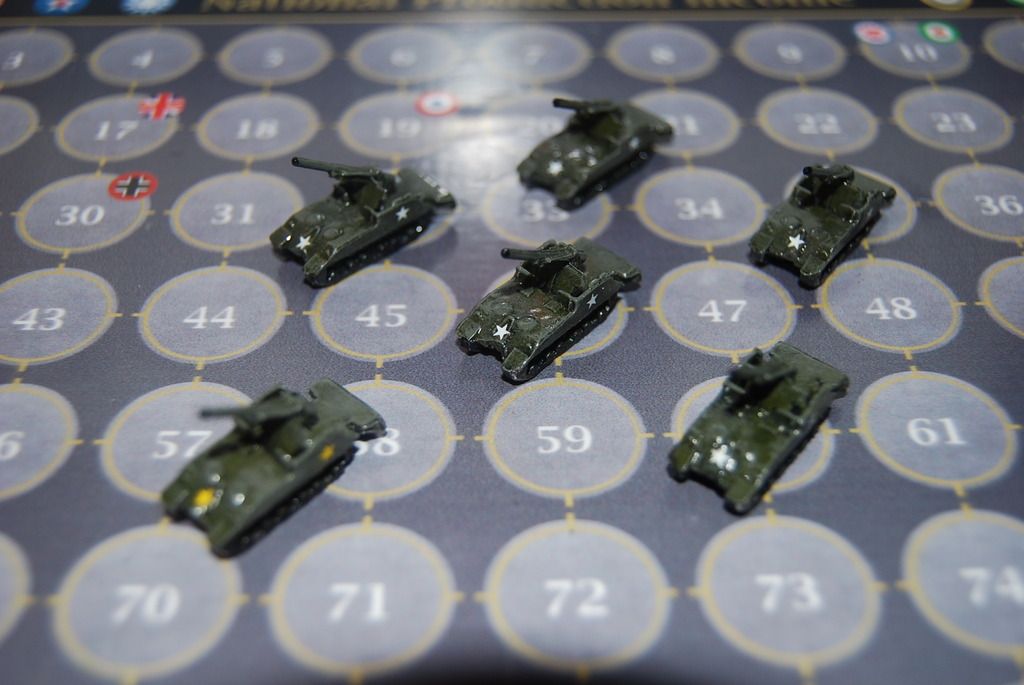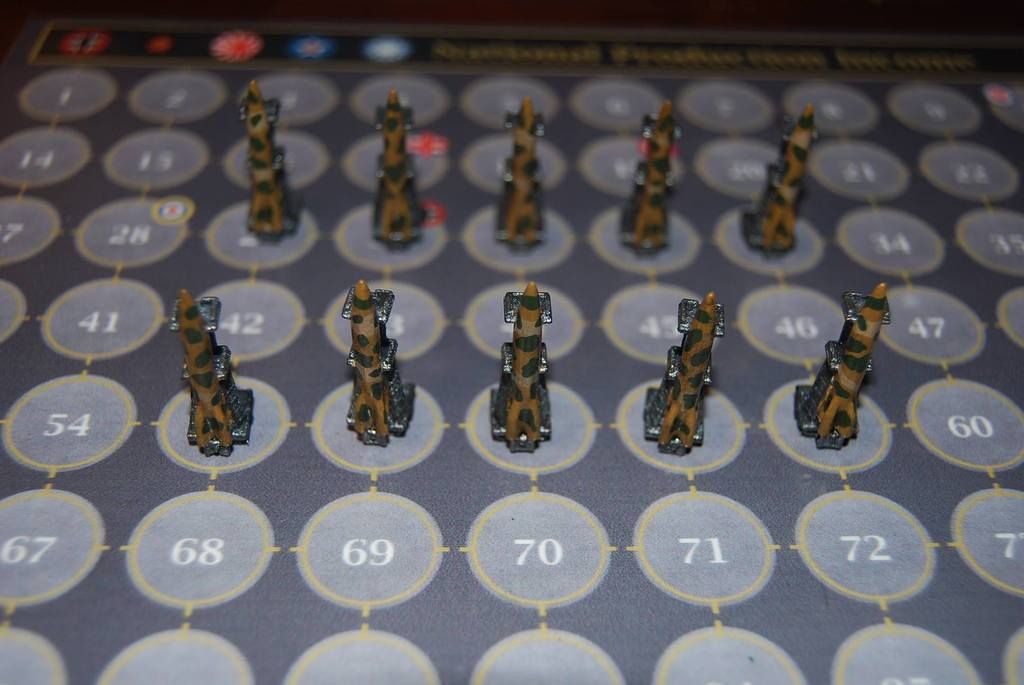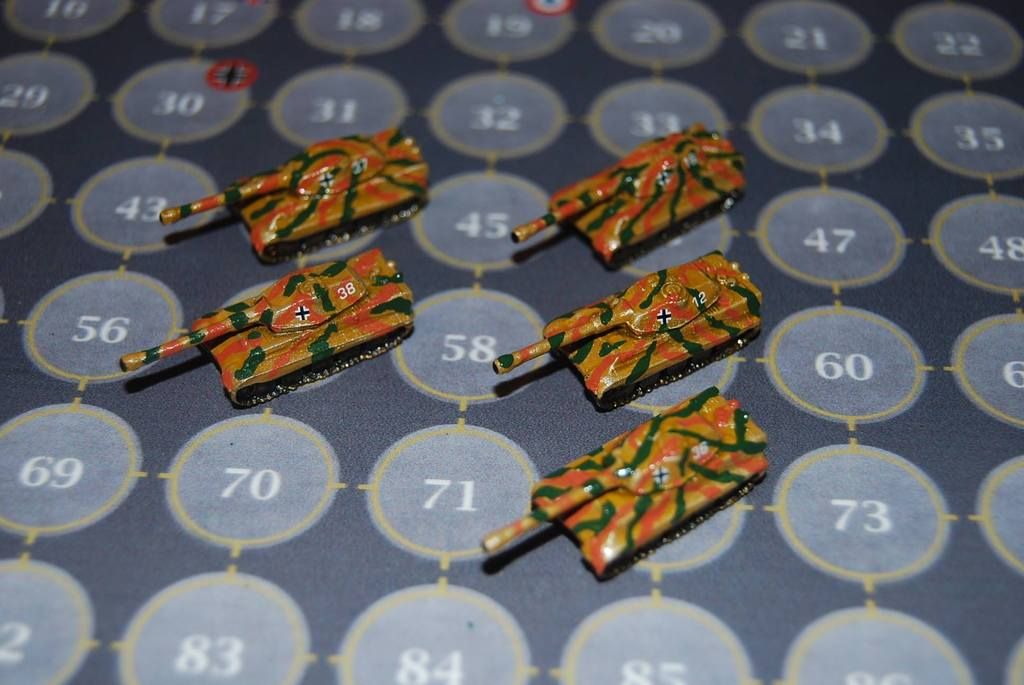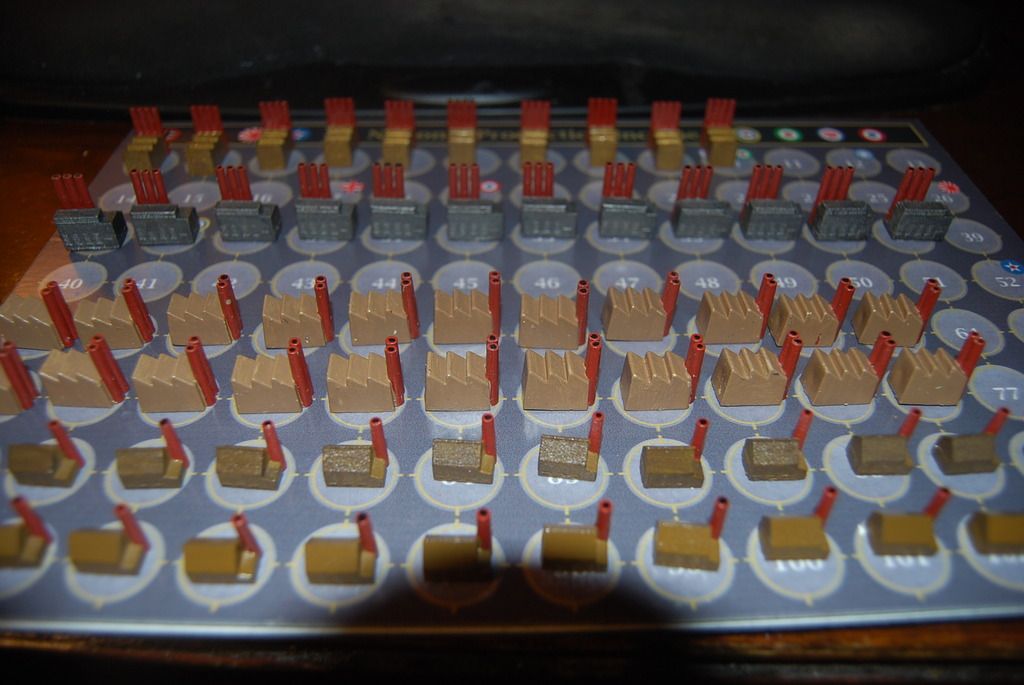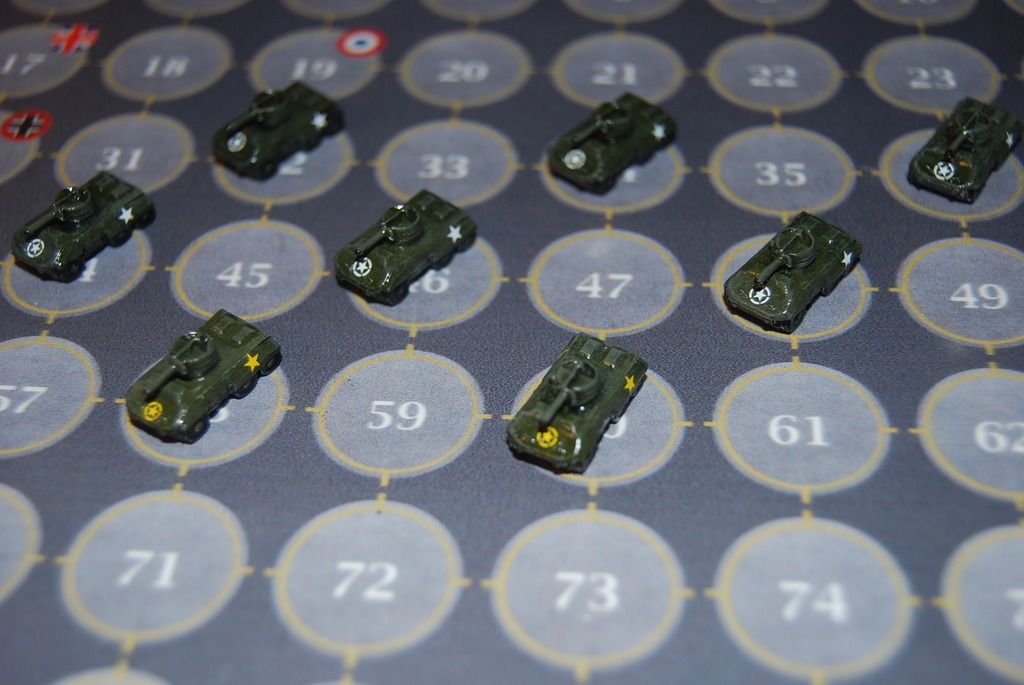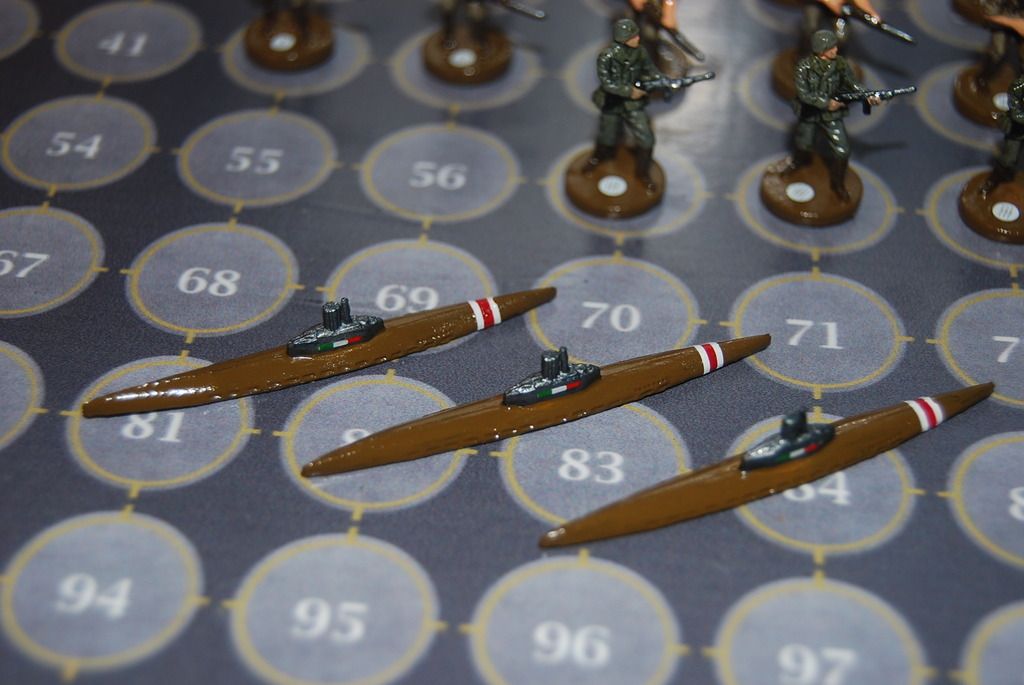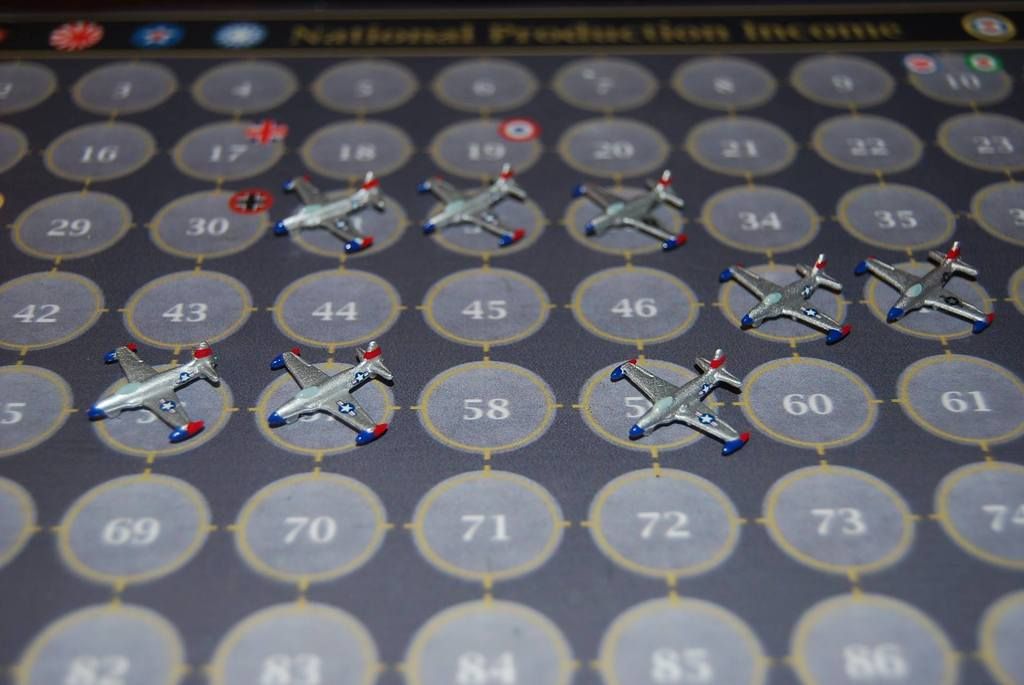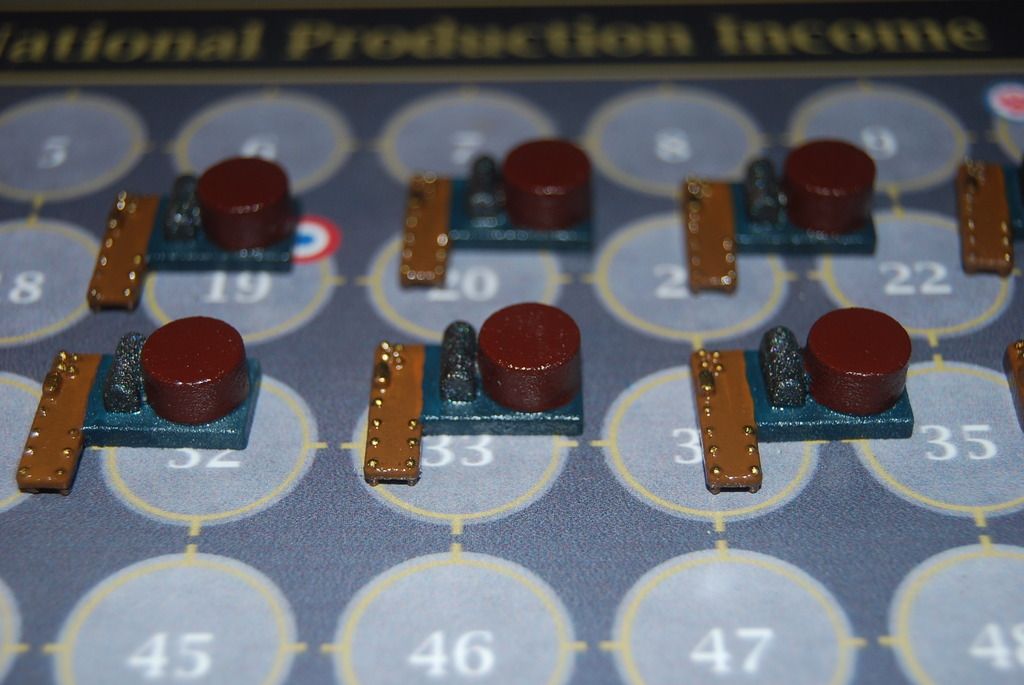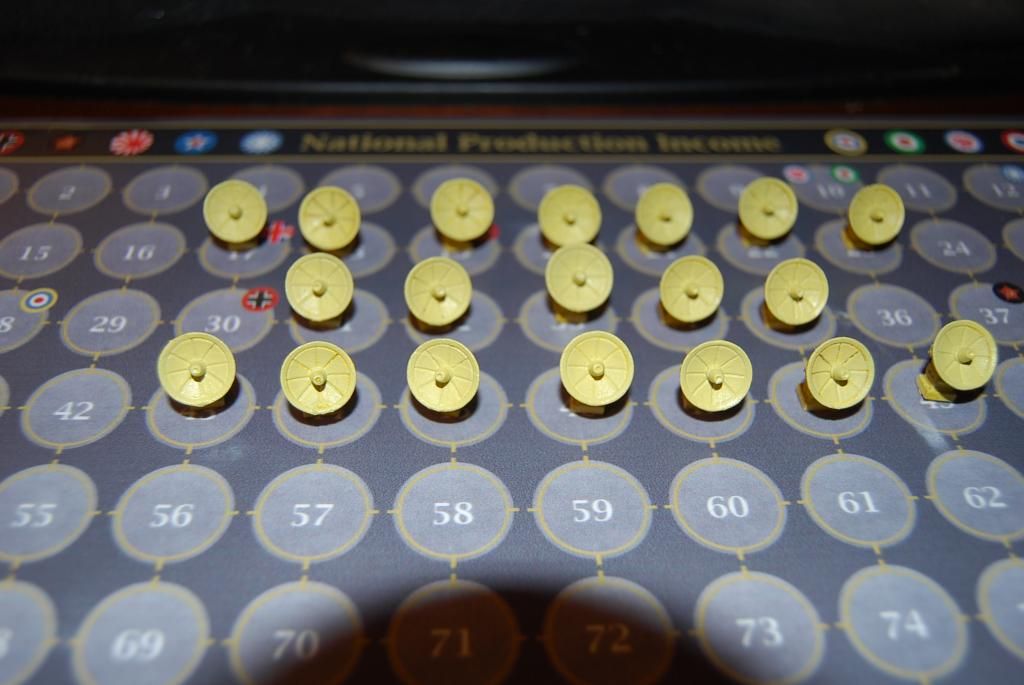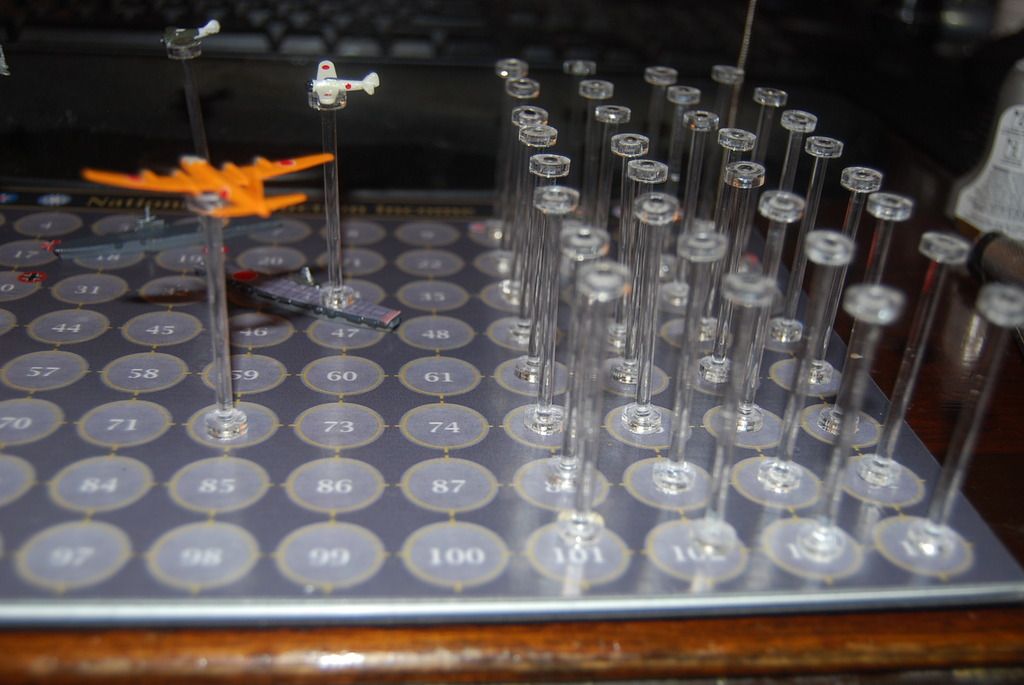I just tried to addressed to the one of the main complaint about Japan’s power in Anniversary and claimed that having Japan with that power is not a must for maintaining balance but happy to see different income distirbutions with No’s or not.
Concerns and Balance Problems with 42.2
-
What a great question! I think the minimum change is to move the Caroline Islands carrier one space west, to the Philippines. With no carrier that can move into Hawaii, the max Japanese attack is 1 sub, 1 cruiser, 1 fighter, 1 bomber – plausible if you insist on a gambit, but not a huge TUV swing.
However. My heart longs for a 1942 setup featuring the Battle of Midway, not the Battle of Delayed Pearl Harbor. Can we move enough American ships to midway to keep things interesting?
A Pacific Canadian fleet is a neat idea – where else might it sail to other than reinforcing the Americans?
-
What a great question! I think the minimum change is to move the Caroline Islands carrier one space west, to the Philippines. With no carrier that can move into Hawaii, the max Japanese attack is 1 sub, 1 cruiser, 1 fighter, 1 bomber – plausible if you insist on a gambit, but not a huge TUV swing.
However. My heart longs for a 1942 setup featuring the Battle of Midway, not the Battle of Delayed Pearl Harbor. Can we move enough American ships to midway to keep things interesting?
A Pacific Canadian fleet is a neat idea – where else might it sail to other than reinforcing the Americans?
To remake Midway, I believe you move all DD, Sub, Carrier, 1 Fg from Hawiian SZ and add 1 US Fg (bid).
Both IJN and USA fleet will be obliterate with only a US BB and a Bomber if lucky.Both Powers will have to rebuilt, but Japan cannot built as fast as US.
-
Well, I do like the idea of having the fleets (optionally) annihilate each other near Midway – if they do, then as you say, the USA could rebuild faster afterward, just like in real life! It would be very thematic.
The problem is that if you move the US Pacific fleet to Midway, then it’s in range of the Japanese home fleet in addition to some of the Japanese forward-deployed warships. By my count, Japan can bring 1 SS, 1 DD, 1 CA, 1 CV, 1 BB, 3 ftr, 1 bmr to Midway on J1 – a truly mammoth fleet for this map. Even if you take every US Pacific warship from Hawaii and San Francisco and add 1 more American fighter, that’s still only 1 SS, 2 DD, 1 CV, 1 BB, 2 ftr.
When I run that battle on the AA calculator, I’m seeing an average outcome where Japan wipes out all USA units (87% chance) and still has 1 CA, 1 CV, 1 BB, 1 ftr to hold the sea zone (average; sometimes better, sometimes worse). With only 2 ftr, 1 bmr available for an A1 counter-attack, American is powerless to counter-attack the Japanese survivors, and Japan eventually reunites its fleet at a large profit. I think this would actually make it harder for the Allies to do a KJF opening than a standard OOB game – the Allies would probably rather leave the boats in Hawaii and San Francisco, and just bid the fighter on the Pearl Harbor carrier!
Am I understanding your scenario correctly?
-
Not exactly.
1- move all in Midway SZ: US 1 DD, 1 Sub, 1 Carrier, 1 Fg from Hawiian SZ and add 1 US Fg (bid).
2- Japan on Midway SZ bring 1 DD, 1 Sub, 1 Carrier, 1 Cruiser, 1 BB, 1 bomber, 1 Fg.
3- Use 1 TP, 1Art, 1 Inf, 1 Fg to take Midway
4- US can attack 2 Fgs, 1 Bomber, 1 BB, 1 DD on remaining IJN fleet.
(1 BB, 1 Carrier, 1 or 2 Fg, 1 TP, 1 bomber returning Japan) and Midway is taken.
Both IJN and USA fleet will be obliterate with only a US BB and a Bomber if lucky.
If you feel AAcalc is not enough generous, add a US Cruiser in addition to other Fg (bid) to Midway.Luck should swing both battles so at the end of it, either US or IJN had 1 or 2 units survived.
If IJN remained.
Next turn, there is 1 Art and maybe 1 Inf with BB to invade Hawaii, VC.
Historically, one intent of Admiral Yamamoto was to destroy US fleet and take Hawaii so US will sign peace or need time to be able to act in PTO.
This scenario is possible.
US player in such case may decide to go KGF and not invest a lot into West Coast fleet (1 TP) remaining plus Panama Cruiser, maybe. -
I think a Midway opener would be fun. One issue I see is that Midway island itself is pretty useless for either side. It has no ipc value and only a single infantry unit. With so little at stake, Japan has no reason to peel forces away from the naval engagement to actually take the island. Perhaps a high value but weakly defended target would help, such as a bomber on the island?
The trick with trying to script Midway into a single combat turn, is that it’s hard to create a carrier trade that allows for somewhat historical results (this mainly owing to how carriers are typically used in combat by players.) I think you’d have to approach the “battle” as taking place over 2 turns. First the Japanese attack, and then the American counter attack.
The goal there would be that Japan has to expose one of their carriers to an immediate counter by US, in order to make a profitable attack in the first place. And for their part the US should have a way to come out ahead in the carrier trade, with at least 1 deck still at the ready following the initial attack.
I think this might recommend not changing the sz53 situation, but instead concentrating on how to set up a Midway battle just with additional units for both Japan and the US. (Instead of moving already existing units.) I imagine the situation in sz53 as representing an extension of the Midway fight under those conditions. Japan should have a strong reason to attack Midway, but not enough to hit both Midway and Pearl at the same time. This would free up the Pearl units to be used in a US counter.
It all seems a little tricky to set up, but at least it would have the advantage of being a dramatic close to the first round.
:-D -
OK, Baron, so it sounds like you’re only proposing to move the Hawaii battle group to Midway (and add 1 ftr), without moving the San Francisco BB. I still say that the battle you’re proposing sounds like a lot of fun and very thematic, but it seems to me that any serious Japan player would choose to send the full fleet of 1 SS, 1 DD, 1 CA, 1 CV, 1 BB, 3 ftr, 1 bmr – not just the more limited fleet you propose of 1 SS, 1 DD, 1 CA, 1 BB, 1 ftr, 1 bmr. Japan has no special need to take the island of Midway on J1.
Can we block off the Japanese BB + CV so that they can’t reach the Midway battle on J1? Maybe that Canadian Pacific fleet you mentioned could be in position to move to Wake Island or something, so they have a choice of either screening the US fleet or reinforcing the US fleet. I worry that the Canadians would have to block two separate sea zones, though, which is rarely cost-effective.
What if we…
(1) Move entire Hawaii naval group to Midway
(2) Add 1 British fighter (bid) in Western Canada
(3) Move the San Francisco battleship to Midway (max total Midway fleet: 1 SS, 1 DD, 1 CV, 1 BB, 2 ftr)
(4) Move Caroline Islands carrier group back to Philippines, and
(5) Add 1 Russian bomber to Moscow.That would allow a max Japanese attack of 1 SS, 1 DD, 1 BB, 2 ftr, 1 bmr, which is pretty much a 50-50 battle! If the UK does not reinforce with the bid fighter, then Japan has 85% odds to win the Battle of Midway, but not much is likely to survive past the bomber and battleship, and the USA can counter-attack with 1 DD, 2 ftr, 1 bmr, which will easily kill off the surviving Japanese BB at a profit. If you build a Pacific carrier on A1, you could probably also use the San Francisco transport to attack the surviving Japanese bomber after it lands – you’d have, e.g., 2 inf + 1 ftr vs. 1 inf, 1 bmr on Wake Island, and 1 DD, 1 ftr, 1 bmr vs. 1 BB in the Midway sea zone.
Other options for the W. Canada fighter, if it doesn’t land on the American carrier, include helping to pick off surviving German subs off the coast of the Eastern US, or flying to the Scotland sea zone to land on a new British carrier in the Atlantic. It gives the Canadians a bit more involvement in the war, and helps the Allies choose whether to establish parity in the Pacific on round 1, or whether to start at a small deficit in the Pacific in order to get a faster start in the Atlantic.
I’m not even sure if I like this better than the A0 turn, or if starting setup changes are “lighter” edits than changing where in the turn order to start the game. I do think this would get you an interesting Midway battle, and that it would be relatively balanced in terms of Axis vs. Allies and Atlantic vs. Pacific.
Black Elk, I agree with your thoughts about how the island of Midway itself is pretty useless, and I agree that it’s desirable to setup an A1 counter-attack on a carrier that’s necessarily exposed as the result of a J1 attack. However, I’m not sure that even an undefended bomber would be enough of an incentive for Japan to alter its J1 naval battle plan – there are about 80 IPCs of expensive hardware at stake for each side in the opening naval battle, so taking out a 12 IPC bomber is not a good reason to accept a risk of losing the naval battle. I guess if that bomber turned out to be crucial to the A1 counterattack, then killing the new Midway bomber could be part of a solid Japanese strategy, but Japan really needs its sole surviving transport to operate in Asia – I’d hate to force them to use that transport in Midway; it kind of narrows the range of the available Japanese openings. You could give the Japanese a second surviving transport, but then that changes the Asian land war, and pretty soon you’ve got an entirely new starting position, not just a Pacific naval fix.
I’m also concerned (Gosh, when am I not concerned?) that giving America an entire second task force in the Pacific is too powerful for the Allies. If you want to give the Japanese an interesting choice between hitting Hawaii and hitting Midway, and you also want to trap a Japanese carrier near Iwo Jima, then you need a fleet in each sea zone that can stand up to an attack by, e.g., 1 SS, 1 DD, 1 CA, 1 BB, 3 ftr, 1 bmr. The defending fleet needs to inflict enough casualties that, on average, the attacking fleet will be vulnerable to a profitable counter-attack. So a lone carrier, even fully loaded, isn’t going to stand a chance; it needs some serious support ships. Let’s say you have 1 British fighter as the ‘swing’ unit that can land in either the Hawaii Sea Zone or the Midway Sea Zone. So now the Americans need something like 1 CV, 1 ftr, 1 SS, 2 DD, 1 CA in Hawaii and in Midway, so the Allies start with a total of 2 SS, 5 DD, 2 CA, 2 CV, 1 BB, 3 ftr in the water in the Pacific, plus the Midway bomber (if desired) and (presumably) the Hawaii fighter and the 2 ftr, 1 bmr that start on the US mainland. That’s just an insanely high level of total unit value. Maybe it could work if the Japanese are able to reliably sink enough of it (but not all of it) on J1, but it makes me anxious. What if the British fight and win the battle in SZ 37, sinking a Japanese BB and CV and denying the Sumatran fighters access to a J1 Midway battle? I feel like just a couple of dice going the wrong way could bury Japan under a ton of Allied naval firepower starting on round 1, without any chance for Japan do get a better outcome through skillful play – you might see Japan get helplessly crushed in as many as 1 out of 3 games.
-
My intent was to be as close as possible to Midway battle history to launch J1.
It needs a J1 and a US1 counter attack.There was no US BB in this Battle. Hence had a US Cruiser (bid) and keep West Coast in SZ.
There was IJN BB and Carrier, we need it to get historical accuracy theme.
Japan throw pretty much all they got in this battle to destroy the remaining US Carriers (Hornet, Enterprise and Yorktown)I like the 1 StB addition on Midway. Pretty historical.
It rise stake and interest to conquer this 0 IPC island.
But no thanks for UK Fg in this SZ. Gamey.
Better add another US Fg on Hawaii to be part of US counter attack.My intent is to provide a safe landing spot to conquer Hawaii next.
It is true that a TP is needed on Japan SZ, then add 1 TP and 1 Artillery in Carolines SZ.
So, a direct landing into Hawaii (unoccupied SZ) will be destroy US1 counter-attack.
Midway is a detour and give TP escorting fleet.
The next step, if luck is on Japan side is Hawaii.The OOB set-up is pretty near Midway theme but without any amphibious landing, sad.
Otherwise, why bother to add a different battle instead of keeping OOB and fix the balance.
It will be hard to sell to other if it is not as accurate as possible from Midway battle and fleet involved.It still need fine tuning to get a 60 IJN -40%US success at the end.
But ultimately, there will be not much of the initial units.
So, Japan makes the move or don’t.
While US must try counter attack, unless all IJN fleet has survived and it means suicide counter attack.Third IJN Fg in Manchuria and Japan StB are two units which should shift the J1 Midway above 90%, but this is detrimental to land combat in China.
I agree that a second US fleet is not helping. It demands Japan to commit units to destroy it, otherwise it is the end. I prefer a single US fleet which left Japan decide or not operation MI.
-
My intent was to be as close as possible to Midway battle history to launch J1.
Yes, that’s coming through loud and clear! I applaud your efforts to recreate the historic battle of Midway, but please remember that the battle has to be voluntarily recreated by players on opposite teams. If the in-game incentives are not right, then players will not follow the “script” just for the sake of historical realism!
There was no US BB in this Battle. Hence had a US Cruiser (bid) and keep West Coast in SZ. I like the 1 StB addition on Midway. Pretty historical. Better add another US Fg on Hawaii to be part of US counter attack.
So your suggested bid is 1 CA (with the carrier), 2 ftr (1 extra on Hawaii and 1 extra on the carrier), 1 bmr (on Midway)? Partially balanced by 1 trans, 1 art in the Caroline Islands for Japan? That’s 44 IPCs for America and 12 IPCs for Japan. Are there any other bid units in your proposal?
So, a direct landing into Hawaii (unoccupied SZ) will be destroy US1 counter-attack.
Midway is a detour and give TP escorting fleet.
The next step, if luck is on Japan side is Hawaii.Again, this feels deeply unrealistic to me as a matter of Japanese tactics. Remember, there is no “National Advantage” for either Japan or the USA anywhere in this region, so the only income swing for occupying Hawaii and Midway is 1 IPC per turn. I don’t understand why Japan would dedicate 100 IPCs worth of hardware over two turns to conquering Hawaii. Honolulu is a victory city, but it’s just one victory city, and there’s no obvious path from Honolulu to any other victory city. Even if totally defeated in the Pacific Ocean, USA can always just make a one-time purchase of 10 infantry in Western US, and then the game will be over before Japan can conquer a second victory city in San Francisco. An attack on Honolulu sometimes makes sense as the third Axis victory city, after conquering Leningrad and Calcutta, but it’s really not a reasonable strategy to make Honolulu your first target as the Axis. It’s not worth any money, it doesn’t have a factory, and it’s not on the way to anywhere interesting.
I don’t mean to rain on your parade – I’m pointing out these problems because I think you have good ideas, and I would very much like to see what you come up with if you decide to focus on building an alternate setup where it is optimal or nearly-optimal play for both sides to voluntarily recreate the Battle of Midway.
-
IDK if my proposed set-up is well tune-up balanced.
It needs to be AACalc to see if the average results is as suited.I was providing some reasons to land from Midway to Hawaii.
I agree that historical script is not enough.
The idea is that if MI invasion is working, it blast US Navy out of Pacific and 1 IPC VC is free to take.
That was the main goal with MI, a larger defense perimeter and an outright fleet Supremacy PTO.Japan can then grow monster if US go KGF, and see no more interest in PTO.
And the only moment it worth to get Hawaii VC is on beginning.
Later, India and Center crush and Money Islands defense become priority.If no Midway, US core fleet should get stronger enough to beat IJN by US3-4 and stranglehold Japan.
So, I believe if US fleet can be destroyed and the counter-attack is not efficient (bad rolls), there should be at least 1 BB and 1 TP 50% of time to invade Hawaii with remaining Troops in MI and Wake.
Maybe East Indies fleet Carrier can reinforced Hawaiian invasion BB and TP J2.
The scenario should provides more room to see US building on West Coast and coming.So, the japanese choice should be to attack or to be overwhelmed by US set-up fleet and fleet building capacity too soon. The second option would rely upon grabbing land Strategy taking so much IPCs in main Asia (30 rising to 38 IPCs) to get on par with US by building Carriers, planes and Subs to match US 42-38 IPCs per turn.
Maybe it is also the idea to make US built 10 ground units in Western US, it gives time to Germany.
-
San Francisco Rules:
The Strategic Bomber is now defenseless (no hit-points in normal combat): Attack 0, Defend 0, at a new cost of 5 ipcs.
Its role is for SBR exclusively.Naval M3
Trying to keep it nice and clean.
http://www.axisandallies.org/forums/index.php?topic=36518.msg1626192#msg1626192
Any takers?
:-D -
This thread is completely derailing from Opening posters intent. :-D
Now, it is clearly doomed to HR hellish Chaos.
:-D -
Hehe yeah
Unfortunately the op hasn’t returned since the moderators moved this thread down here into the graveyard. So now it is up to our HR voodoo to give it a zombie afterlife.
:-DI think taamvan had his main issue adressed. There is general agreement that the Axis advantage is pretty extreme requiring a sizeable bid. That corrective is fairly straightforward, and there’s not a whole lot more we can say on it.
This approach is an alternative way of addressing his Allied “spinning plates” problem. A 2 line change to the ruleset, that dramatically tweaks the gameplay, puts another VC in contention, makes bombing and the naval game more robust, and provides a potential departure from the center crush. I think it’s not half bad given the circumstances.
I agree that the bomber change plays much better under intercept conditions, but that option is available with the basic concept introduced on page 14 of the manual. For those who don’t like interception, it might be possible to simply raise the factory aaafire from a hit 1 to a hit 2 as an alternative balancing option for SBR? Or you could just try it as is, and let the bombers be a bit more powerful. There is still an upward ceiling on their potential effectiveness even under no intercept (otherwise OOB SBR conditions) just based on the production cap. I think I prefer intercept as the recommended standard, or just letting the bombers be more potent if the player decides to go no intercept. On the whole I think it does a lot, combined with the move 3 at sea idea, for a relatively simple implementation.
For balance by sides it opens up significant variety in the quest to determine who has the advantage, because now the Axis have to consider how to manage their coastal defenses against the naval move 3, as well as their new offensive options on the water, vs the traditional center crush. Now the Axis have some spinning plates of their own, and everyone has new strategic options to consider.
:-D -
Yes, I think moving this post to House Rules was a self-fulfilling prophecy! :-p
I’d be perfectly willing to try out the ‘West Coast rules.’ I like the name. I’m not sure which ‘extra’ VC is supposed to be put in play by the west coast rules, but it certainly would shake things up. Here are some changes that I notice right off the bat:
-
The Russian sub can hit the German Baltic fleet on R1
-
The German Baltic fleet can hit Archangel or reinforce Morocco on G1
-
The British Indian fleet can reinforce Buryatia on B1
-
The British Australian fleet can hit Borneo on B1 (allows 4 inf vs. 1 inf attack)
-
Defenseless bombers mean that the German Med fleet is pretty safe against a B1 attack as long as Germany closes the canal.
-
The Japanese should be able to eliminate all US boats in the Pacific, including San Francisco, on J1
-
San Francisco and Tokyo are now one sea move away from each other
-
There aren’t really any safe sea zones in the Pacific any more – anywhere you might want to park your fleet is a one turn’s move from your opponent’s next naval build.
-
America can directly attack/reinforce France from the Eastern US with one naval move
It’s very difficult for me to predict if the loss of American naval TUV in the Pacific will be balanced out by the faster routes to France and Borneo!
Baron Munchhausen, thanks for clarifying your thoughts on the Battle of Midway issue. I have a better idea of where you’re coming from now. I don’t think that J1 or J2 is the time to go for Honolulu on this map, but we can agree to disagree about that. Maybe someday we’ll get to play a game together, and you can play Japan, and I can “explain” why you shouldn’t take Honolulu by crushing your navy! :-)
-
-
If you check the specs on the Indian and Aussie fleets, you’ll see that the UK has a viable option vs the Japanese fleet at Truk. If UK handles this Japanese carrier in sz50, then I don’t see how a sweep of the USN in the Pacific is possible on J1. Their Japan fighter couldn’t reach sz53 or sz56 in that case, and their bomber is not a combat unit under this ruleset.
The extra VC in contention is San Francsisco itself, which would no longer be totally out of range of Japanese production. Hence the name
:-DI think what you’re going to end up with is a situation in the Pac where Japan has an early incentive to keep a defensive fleet in sz 60, and US has an early incentive to keep a defensive fleet in sz 56. It would be risky for either nation to gun across the Pacific right away with their main fleet. So they’re likely to build up and stare each other down for a time, peeling off with some smaller task forces and transports away from the main fleets to activate the south Pacific, while they try to gain the upper hand in the cat and mouse between sz56 and sz 60. Towards the endgame one side or the other, might say “screw it!” and take a chance vs the opposing production center, but I think it would take a little while for the game to reach that point. In the meantime it gives Japan and America an incentive to keep some fighters, ships and ground forces in place for the Pacific contest, rather than simply launching everything against the center.
I think you’d see a similar situation with Germany and the US/UK, where there is a stronger incentive to keep fighters and ground near the Atlantic, rather than launching everything toward the center.
The center crush isn’t off the table for Axis, but it would be riskier for them to just throw everything at Moscow immediately and leave nothing behind for coastal defense, or the broader naval contest.
-
That’s fair, and the Truk attack is interesting. Does the Truk attack become mandatory? I.e., any other action(s) by the UK Pacific naval assets is obviously much worse than Truk?
-
San Francisco Rules:
All naval units now move 3.
The Strategic Bomber is now defenseless (no hit-points in normal combat): Attack 0, Defend 0, at a new cost of 5 ipcs.
Its role is for SBR exclusively.Trying to keep it nice and clean.
http://www.axisandallies.org/forums/index.php?topic=36518.msg1626192#msg1626192
Any takers?
:-DIMO, for 1942.2, it should be Move 3 NCMs but only Move 2 if doing Naval combat or amphibious landing.
-
That would certainly be more conservative. But I guess from my perspective, it just seems more interesting to go all the way with it, and then see what sort of play patterns emerge.
One of the criticisms of the game is that it moves rather slowly, and after hours of planning and building up to a crescendo, there is this kind of anticlimax, where the end is too predictible. Players can see it coming before it arrives, and this is often at the point when people have become somewhat fatigued. Many games end by concession before the war has really been decided, or more frequently the player with less endurance goes into “hurry up” mode and just starts doing reckless things to force a conclusion. I’m not saying that everyone shares this view, or thinks that something needs doing to address it, but I think many have encountered the kind of drag on pacing that I’m referring to.
I don’t know if move 3 is the answer, but it would certainly front load much of the action, and perhaps reduce the time requirements necessary to conclude an average game in a satisfying way.
The main advantage I see, is that it throws a totally new spin on the game. Not just on the opener, but on the midgame and the endgame as well. It’s also very simple to understand. There isn’t a whole bunch of new rules overhead you have to deal with, rather its more about puzzling through new strategies and seeing aspects of the gamemap in a new light. For a reset, it offers a pretty substantial change across the board for players to explore, while still retaining a familiar basic character at least in the broad strokes. It could be fun.
To Argo’s Q. I’m not sure if the play on sz50 would be scripted every game, but it certainly seems like a powerful move. There might be a better alternative I haven’t noticed yet, but right now, I think that’s the opening I would choose first time out.
:-Dps. @Baron:
IMO, for 1942.2, it should be Move 3 NCMs but only Move 2 if doing Naval combat or amphibious landing.
Oddly enough, the G40 OOB set up seems to recommend it more than 1942.2 hehe, on account of sz 8. I guess I’m not totally opposed, I just think its rather tricky to force a separation between combat movement and non combat movement at different values. I don’t know if tripleA treats movement that way. Or if it would be too confusing for players to enforce and track face to face. But more than that, I think it would prevent or considerably nerf the exact sort of attack patterns that I’m most intrigued by at the moment.
Even a couple days ago, I wouldn’t have thought I’d be taking up the mantle of arguing for Move 3 ships, but now that I’ve been sitting with the idea, it’s really growing on me. To build on the earlier thought, what I really like about this M3 idea is that it allows you to project power from your core production region against the opponent’s core production regions, without first having to totally show your hand and telegraph your plans so far in advance. The move 2 puts a very hard limit on what can happen on a given turn OOB. But the question “where might they attack next?” at move 3, and you see a number of possible targets that emerge in a given turn.
Part of why I like the tandem rules, defenseless bombers and M3 together, is that it would be such a dramatic reset of the midgame, that players would have to actually play it out, before making major pronouncements on which side is favored. There would just be too many new play patterns to explore for the opener and the midgame to be settled so quickly. And the hope is that changes to the bomber, might be offset by changes to the ships movement, in a way that produces a rather different balance than what we see OOB.I think rather than designer intent at this point, I’m more interested in whether these changes can make the game feel more exciting (or even more historical) with the broader strategies one could employ, simply by enhancing the movement rate on the water, and making the stratB into a purely SBR oriented unit.
Ideally 1942.2 could serve as a dry run for G40.
The implementation is somewhat simpler in 1942.2, and it might not even require a unit set up change, or a change in turn order to get up off the ground.
I once made the argument that the solution to the center crush dilema might be less distance rather than more distance, but with the caveat that Russia be able to actually threaten an offensive vs Japan, so both sides are on an equal footing. (The designer’s solution was to add more distance between Japan and Moscow, the low value “buffer zone” idea.)
I would make a similar argument here. The solution to the Allied/American dilemma at sea might actually be less distance or less time (ie M3 for ships), but with the caveat that both sides have an equal chance to project power and threaten an offensive vs the other guy. In the Pacific this is exemplified by the naval ‘stare down’ between sz 60 and sz 56. Same deal on the Atlantic side with sz 11.
That way, instead of gaming the map for movement and turn order exploits (with plenty of breathing room, and “safe places” to hide in between), it’s more like trying to hold the opponent on guard (or in place) at all times, with threats to their core coastal defenses. Movements away from these defenses on any given turn, have to be measured against the possible danger posed by the other side. More like a cascade of trading pieces in chess (‘if you go there, then I’ll go here!’), rather than a strat that relies so much on numbers crunching, and both sides knowing where the battle is going to occur a full turn out.
Does that make sense?
-
I know that 3 move NCM only is a back up plan.
You described well the on going gameflow over a long period of play.And once the toothpaste is outside the tube, better to try 3 move Combat Move.
I’m sure people will be curious to try it. -
For the M3 ships idea in 1942.2…
Ok just running the numbers on sz 50 and considering the options.
The Japanese fleet at Caroline Is (Truk) is 1 sub, 1 carrier, 1 cruiser, 1 fighter.
Against this the British could potentially bring 1 sub, 1 carrier, 2 cruisers, 1 fighter = odds to the attacker at about 90%. But making this play at those odds requires that you don’t deal with the sz 61 transport, potentially leaving India exposed. If you peel off just 1 fighter to handle sz 61, the odds to the British attacker at Truk drop to around 65%. This is lower odds than the blow out where you bring everything, but still high enough that the British player might seriously consider taking the risk just to shore up India. Its also possible to make a more compelling distraction with the Australian transport, into Borneo for example, or perhaps elsewhere, so that might factor into the British players decision about how much to risk at Truk. All they really need to do for a fairly decisive victory is to ensure that the Japanese carrier is sunk. I think its an interesting battle, where the defender might have to consider their casualty selection priorities on occasion.
I like what M3 does for the Aussie transport in sz 39, but its perhaps even more interesting for the India transport in sz 35. Because this transport could move to Egypt, pick up a tank or artillery unit, then make it back all the way to FIC, or East Indies again.
If they want to run, this transport could get all the way to South Africa (and then be in a position to move to sz 23 the following round.)
A possible alternative to the Truk attack (perhaps not a great one, but just thinking out loud), might be to cut and run to sz 29 off Madagascar with the whole British Pacific fleet. I struggle to see how this really pans out, unless perhaps the plan is to consolidate and then rush the Med if the canal remains open, maybe with like a DD block purchase at India to prevent the Japanese from just blowing past India on the way to Egypt haha?
Or if the canal is open on UK1 and Germany failed to sink the British DD is sz 17, perhaps this unit makes sz 37 somewhat more attractive again. Not least because now UK could grab the Egyptian Tank or Artillery and bring it all the way to East Indies, to ensure that the land battle goes off without a hitch. East Indies itself is somewhat more compelling, because ships stationed in sz 37 could reach one move farther from this position now (this is kind of a downside for Allies on UK1, since Japan could respond) but it also makes the island more attractive long term, if the Allies managed to secure it and expand production there.
I still think sz 50 is preferable to all these, but its hard for me to say. There’s just a lot more going on at M3 that you have to account for. Which is part of the charm I think
:-DBut even if the play was so strong as to be the obvious script, I wouldn’t really mind so much. Sure it would be cooler if the battle was a bit more historically grounded, but if this is what it takes to bring balance back to the Pacific, I’d say it’s at least an improvement over the current OOB sweep by Japan. It also really underscores the significance of Truk to Japan, for any Allied player who let’s that carrier slip away unscathed hehe.
Finally, it’s not as if we don’t have still have options to do more if needed. We could still explore a minor set up change, or the addition of a 3rd rule to the San Francisco HR set, if M3 needs something more to work the way we want it to (like to deal with an India crush or some other unforeseen issue over the horizon). There’s always a bid option as well, for a final fall back. But right now, I like what it does for the Pacific. I like what it does for Germany’s naval potential. And I really like what it does for the Atlantic crossings by US.
-
Any suggestions?
Without reading the rest of the thread, I’ve found that this map is difficult to lose as allies, regardless of the bid if you win the assault on SZ37 UK1 (Perhaps I haven’t played against enough experienced opponents though.). Otherwise it is difficult to win. That is what makes the map somewhat broken for me because that attack in SZ37 is a coin flip.
Moves are:
USSR:
Strafe West Ukraine IIRC with everything that can reach (perhaps barring one plane).
Hit Belorussia, not Baltic States.
Attack West Russia with everything else that can reach
Abandon Karelia.
Pull back to Yakut IIRC
Reinforce ChinaUSA:
Build IC on China, fly fighters to Yakut. Later build 1arm per turn on China.Losing West Russia is pretty much fatal. Max force needs to be applied to reinforcing this.






